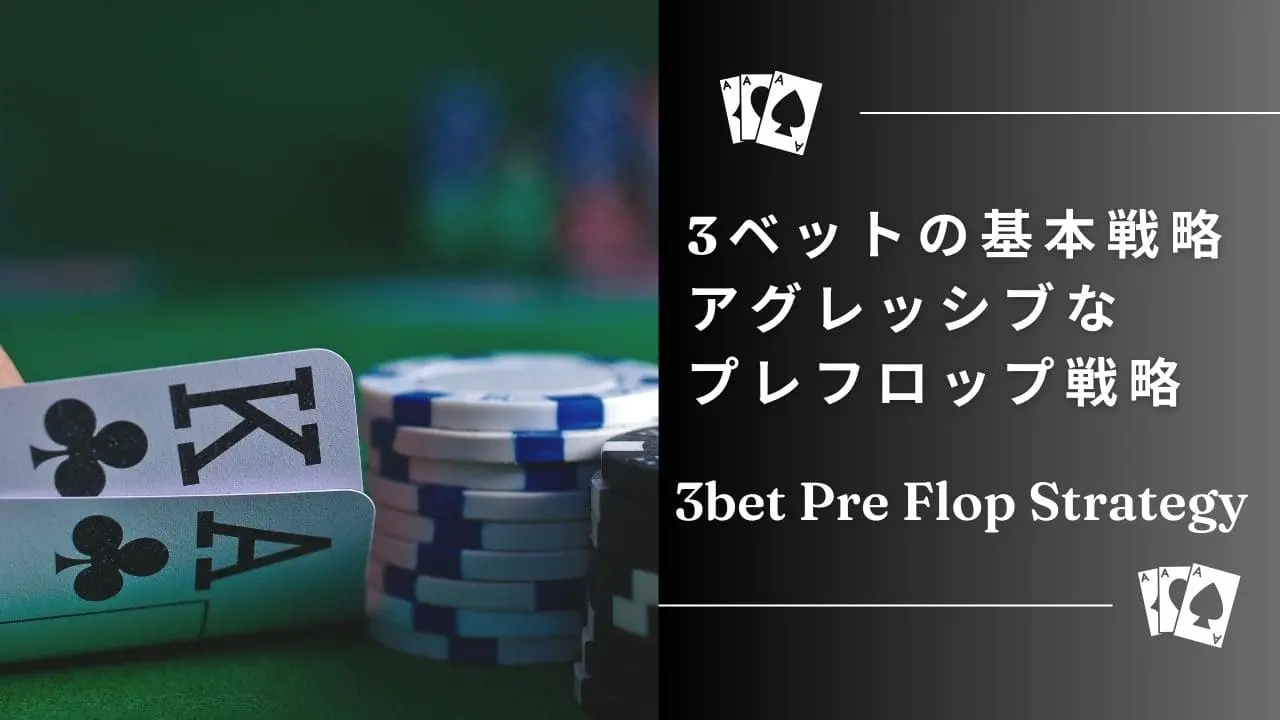A 3-bet is a powerful preflop strategy in poker that can significantly influence the flow of the game. This article covers the fundamentals of 3-betting, including its optimal timing, benefits, risks, and how to apply it effectively in real play.
The Importance of 3-Betting
1. Controlling the Pot Early
By making a 3-bet, you dictate the pot size before the flop, allowing you to steer the action in your favor. This reduces post-flop complexity and increases your chances of winning.
Example
If you’re in middle position holding QQ, a 3-bet discourages opponents from limping in or making loose open-raises. This ensures you maximize value from your strong hand while preventing unfavorable multiway situations.
2. Applying Pressure on Opponents
A 3-bet signals strength, forcing opponents to narrow their hand range and make tougher decisions. This is particularly effective against loose players who frequently open with a wide range of hands.
Example
A loose player on the button opens with K8 suited, and you’re in the big blind holding A10 offsuit. A 3-bet here helps you gain control of the hand and put your opponent in a difficult spot.
3. Protecting Your Hand
3-betting reduces the likelihood of multiple players seeing the flop, decreasing the risk of your strong hand getting cracked.
Example
If you hold AA and don’t 3-bet, multiple opponents might call, increasing the chances of someone hitting a straight or flush. A 3-bet isolates the field and maximizes the strength of your pocket aces.
The Power of 3-Betting
3-betting isn’t just about aggression—it’s about dictating the game and gaining a psychological edge over opponents.
1. Psychological Pressure
A 3-bet forces opponents to second-guess their hand strength and makes it harder for them to put you on a specific range.
Example
Incorporating semi-bluff 3-bets into your strategy keeps opponents off balance, preventing them from accurately reading your hand.
2. Balancing Risk and Reward
While 3-betting carries risk, managing it effectively can yield substantial rewards. Successfully forcing an opponent to fold allows you to pick up chips effortlessly, while well-timed value 3-bets ensure maximum profit from premium hands.
Example
If you hold A5 suited, a semi-bluff 3-bet against an aggressive opponent can either force a fold or create favorable post-flop opportunities, such as nut flush draws.
3. Expanding Your Strategic Range
3-betting isn’t limited to value hands—it can also be used for bluffs and semi-bluffs, making your play unpredictable.
Example
By incorporating 3-bets with hands like KQ suited from the cutoff, you make it harder for opponents to counter your strategy.
Understanding 3-Bet Basics
What is a 3-Bet?
A 3-bet is a re-raise against an initial open raise. For instance, if a player raises to 2BB, and another player re-raises to 6BB, this constitutes a 3-bet.
Key Terminology
- Open Raise – The first raise in a betting round.
- 3-Bet – A re-raise against the open raise.
- 4-Bet – A re-raise after a 3-bet.
Mastering these concepts is essential for executing a successful 3-bet strategy.
Executing an Aggressive Preflop Strategy
Advantages of an Aggressive Preflop Strategy
- Forces weaker hands to fold.
- Allows early pot control.
- Deceptively disguises hand strength.
Optimal Use of 3-Betting
A well-timed 3-bet narrows your opponent’s range and sets you up for success post-flop. For example, 3-betting against a tight player forces them to continue only with premium hands, making their decisions more predictable.
Key Factors for Effective 3-Betting
1. Position Matters
Position is a crucial factor in 3-betting. Late positions like the button (BTN) and cutoff (CO) offer the best opportunities for effective 3-bets.
Example
A button 3-bet takes advantage of positional leverage, allowing you to act last post-flop and dictate the action.
2. Analyzing Opponent Playstyles
Adapting your 3-bet strategy based on opponent tendencies is essential.
Against Loose Players
Frequent open-raisers with weak hands can be pressured into folding by aggressive 3-bets.
Example
A loose middle-position player raises with A9 offsuit. If you have QQ or AK on the button, a 3-bet puts them in a tough spot.
Against Tight Players
Since tight players only continue with strong hands, bluffing them is risky. Instead, focus on value-heavy 3-bets.
3. Understanding Risk and Proper Execution
Balancing risk and reward is key to a successful 3-bet strategy.
- Managing 4-Bet Responses – Be prepared to fold against strong 4-bets when bluffing.
- Avoiding Excessive Bluffing – Overusing bluff 3-bets makes you predictable. Mix in value hands to keep opponents guessing.
Practical 3-Bet Scenarios
Scenario 1: 3-Betting with KK in the Cutoff (CO)
- Situation: An early-position player opens to 2.5BB.
- Action: A 3-bet to 7.5–10BB maximizes value and isolates the opponent.
- Adjustment: If faced with a 4-bet, evaluate stack sizes and opponent tendencies before proceeding.
Scenario 2: Semi-Bluffing with A5 Suited on the Button (BTN)
- Situation: A middle-position player opens to 3BB.
- Action: A 3-bet to 9BB pressures weaker holdings while leveraging potential flush draws.
Scenario 3: Defending in the Small Blind (SB) with AQ Offsuit
- Situation: The button raises to 2.5BB.
- Action: A larger 3-bet (around 10BB) compensates for positional disadvantage and forces tough decisions.
Scenario 4: 3-Betting with Pocket Tens (TT) from Under the Gun (UTG)
- Situation: A middle-position player raises to 3BB.
- Action: A disciplined 3-bet of around 10BB helps control the pot while testing the opponent’s range.
Scenario 5: Aggressive Defense with KJ Suited in the Big Blind (BB)
- Situation: A cutoff player opens to 2.5BB.
- Action: A 3-bet to 9BB applies pressure and maximizes KJ’s post-flop playability.
Pro Tips for Mastering 3-Betting
- Adjust bet sizing based on opponent tendencies and stack sizes.
- Observe reactions post-3-bet to refine future plays.
- Leverage opponent weaknesses by exploiting tendencies (e.g., bluffing against frequent folders).
Summary
3-betting is a cornerstone of aggressive preflop strategy. By understanding the fundamentals, recognizing optimal scenarios, and adjusting to opponent tendencies, you can enhance your poker game significantly. Continue refining your skills through study, practice, and real-game experience.


